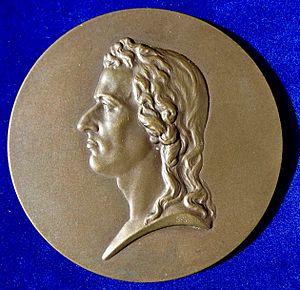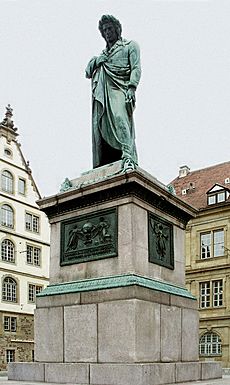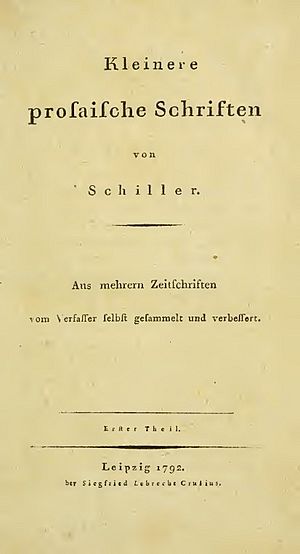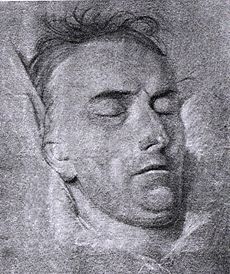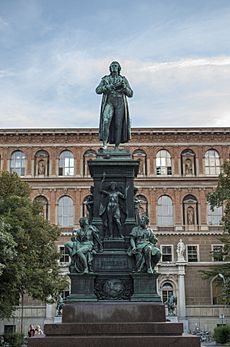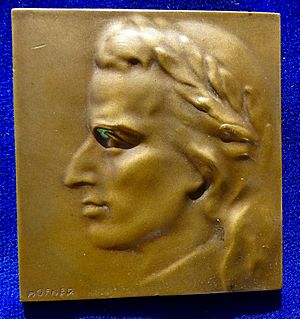Friedrich Schiller facts for kids
Quick facts for kids
Hofrat (Saxe-Meiningen)
Friedrich Schiller
|
|
|---|---|
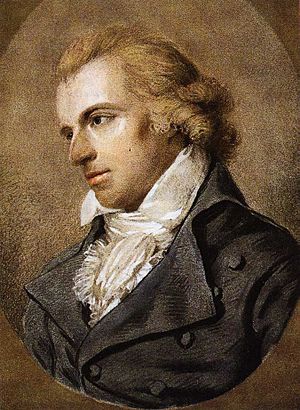
Portrait of Schiller by Ludovike Simanowiz (1794)
|
|
| Born | Johann Christoph Friedrich Schiller 10 November 1759 Marbach am Neckar, Duchy of Württemberg |
| Died | 9 May 1805 (aged 45) Weimar, Duchy of Saxe-Weimar |
| Occupation | Poet, playwright, writer, historian, philosopher |
| Nationality | German |
| Literary movement | Sturm und Drang, Weimar Classicism |
| Notable works |
|
| Spouse |
Charlotte von Lengefeld
(m. 1790) |
| Children |
|
| Relatives |
|
| Signature | |
 |
|
Johann Christoph Friedrich von Schiller (German: [ˈjoːhan ˈkʁɪstɔf ˈfʁiːdʁɪç fɔn ˈʃɪlɐ], short: [ˈfʁiːdʁɪç ˈʃɪlɐ]; November 10, 1759 – May 9, 1805) was an important German playwright, poet, and philosopher. He is known as one of the greatest writers of the German language.
For the last 17 years of his life, Schiller became good friends with the famous writer Johann Wolfgang von Goethe. They often talked about art and ideas. Schiller encouraged Goethe to finish his works. This friendship led to a special time in German literature called Weimar Classicism. They also worked together on Xenien, a collection of short satirical poems. In these poems, they challenged people who disagreed with their ideas.
Contents
Schiller's Early Life and Education
Friedrich Schiller was born on November 10, 1759, in Marbach, in a German state called Württemberg. He was the only son of a military doctor, Johann Kaspar Schiller, and Elisabetha Dorothea Schiller. He also had five sisters.
Schiller grew up in a very religious Protestant family. He spent a lot of his childhood studying the Bible. This later influenced his plays. When Friedrich was born, his father was away fighting in the Seven Years' War. The family moved often because of his father's military work.
In 1763, after the war, his father became a recruiting officer. The family moved to Schwäbisch Gmünd and then to Lorch. In Lorch, Schiller started school. His parents wanted him to become a priest. So, the village priest taught him Latin and Greek. Schiller later named a character in his first play after this good teacher. As a boy, Schiller loved the idea of being a priest. He would often pretend to preach.
In 1766, the family moved to Ludwigsburg. Schiller's father had not been paid for a long time. The family needed to find a more stable place to live.
Schiller's Time at Karlsschule
In Ludwigsburg, young Schiller caught the attention of Karl Eugen, the Duke of Württemberg. In 1773, Schiller entered the Karlsschule Stuttgart. This was a special military academy founded by the Duke. There, Schiller studied medicine. He often suffered from illnesses throughout his life and tried to cure himself.
While at the Karlsschule, Schiller read books by famous thinkers like Rousseau and Goethe. He talked about Classical ideas with his classmates. During this time, he wrote his first play, The Robbers.
The Robbers: A Play That Made History
The Robbers was a very exciting play. It was about two aristocratic brothers. The older brother, Karl Moor, leads a group of rebellious students. They become like Robin Hood-style bandits in the forest. The younger brother, Franz Moor, tries to take his father's wealth.
The play showed how society was unfair and supported new ideas about freedom. It shocked the people who first saw it. Schiller became famous overnight. Later, he was even made an honorary member of the French Republic because of this play.
In 1780, Schiller became a doctor in the army in Stuttgart. He did not like this job. He left his army post without permission to see The Robbers performed in Mannheim. Because of this, he was arrested and put in prison for 14 days. The Duke also told him he could not publish any more works.
In 1782, Schiller left Stuttgart. He traveled through several cities before settling in Weimar in 1787. In 1789, he became a professor of History and Philosophy in Jena. During this time, he mainly wrote historical works.
Schiller's Family Life
On February 22, 1790, Schiller married Charlotte von Lengefeld. They had two sons and two daughters between 1793 and 1804. Schiller's last living descendant was his great-grandchild, Baron Alexander von Gleichen-Rußwurm, who passed away in 1947.
Life in Weimar and Later Career
Schiller and his family moved back to Weimar from Jena in 1799. Goethe convinced him to start writing plays again. Schiller and Goethe then started the Weimar Theater. This theater became the most important one in Germany. Their teamwork helped bring back great drama in Germany.
In 1802, the Duke of Saxe-Weimar honored Schiller for his achievements. He was given the noble title "von", which was added to his name. Schiller stayed in Weimar, Saxe-Weimar until he passed away in 1805 at the age of 45. He died from tuberculosis.
Schiller's Legacy and Honors
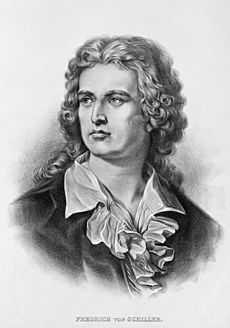
The first official book about Schiller's life was written by his sister-in-law, Caroline von Wolzogen, in 1830. It was called Schillers Leben (Schiller's Life).
In 1827, a coffin believed to hold Schiller's skeleton was placed in the Weimarer Fürstengruft (Weimar's Ducal Vault). This is where the royal family of Saxe-Weimar-Eisenach was buried. Later, Goethe was also buried there. However, in 2008, scientists did DNA tests. They found that the skull in the coffin was not Schiller's. So, his tomb is now empty.
Monuments and Tributes
Many places have honored Schiller:
- In 1839, the city of Stuttgart put up a statue in his memory. The square where it stands was renamed Schillerplatz.
- A Schiller monument was revealed in Berlin's Gendarmenmarkt in 1871.
- In 1859, German-Americans in New York City gave a bronze statue of Schiller to Central Park. It was the first sculpture placed in Central Park.
- Schiller Park in Columbus, Ohio, is named after him. It has a statue of Schiller that was donated in 1891.
- There is also a Friedrich Schiller statue on Belle Isle in Detroit, Michigan. It was put there in 1908 by the German-American community.
- Schiller's image appeared on the 10 Mark banknotes of East Germany in 1964.
- In 2008, people watching the TV channel Arte voted Schiller as the second most important playwright in Europe, after William Shakespeare.
- On November 10, 2019, Google celebrated his 260th birthday with a special Google Doodle.
Schiller and Freemasonry
Some people believe that Schiller was a Freemason, but this has not been fully proven. There are letters from 1829 that mention Schiller being initiated into a Freemason lodge. His great-grandson also said he was brought to a lodge. However, no official membership paper has been found.
Still, Schiller had connections with Freemasonry. For example, in 1784, he got his teaching job at the University of Jena with help from the Freemason Goethe. Also, his famous poem "Ode to Joy" was used in the Ninth Symphony by the Freemason Ludwig van Beethoven. Some of his plays and poems, like William Tell and "The Hostage," also show ideas similar to those of Freemasonry. He was also friends with Freemasons like Carl Leonhard Reinhold and Christian Gottfried Körner.
Schiller's Writings
Philosophical Ideas
Schiller wrote many philosophical papers about right and wrong, and about art. He combined the ideas of Immanuel Kant with those of another German philosopher, Karl Leonhard Reinhold.
Schiller talked about die schöne Seele (the beautiful soul). This is a person whose feelings are guided by reason. For Schiller, beauty was not just about art. It was also about being a good person. He believed that good things are beautiful.
Schiller is often seen as a liberal and a cosmopolitan thinker. This means he believed in freedom and thought of himself as a citizen of the world. His philosophical work focused a lot on human freedom. This also guided his historical research, like his studies of the Thirty Years' War and the Dutch Revolt. These themes then appeared in his plays. For example, the Wallenstein trilogy is about the Thirty Years' War. Don Carlos is about the Dutch fighting for freedom from Spain.
Schiller also wrote about the idea of the sublime. This is about how humans can go against their basic instincts, like wanting to stay safe, to do something great. For example, someone might bravely sacrifice themselves for an important idea.
Famous Plays by Schiller
Most Germans consider Schiller to be Germany's most important classical playwright. He was very creative with how he structured his plays. He also created new types of plays, like the melodrama. Here are some of his famous plays:
- The Robbers (Die Räuber): This play uses very strong emotions and shows a lot of action. It is a key work of the German Sturm und Drang movement, which was about strong feelings and individualism. It is seen as the first European melodrama. The play shows two brothers fighting each other. One wants money and power, while the other tries to start a revolution. The play criticizes unfairness in society and explores what evil is.
- Intrigue and Love (Kabale und Liebe): This play is about a young nobleman, Ferdinand, who wants to marry Luise, the daughter of a music teacher. The politics of the court and Ferdinand's powerful father create a terrible situation. It's a bit like Shakespeare's Romeo and Juliet. Schiller uses this play to criticize powerful rulers and people who pretend to be good.
- Don Carlos: This was Schiller's first historical play. It is loosely based on the real Don Carlos of Spain. In Schiller's play, Don Carlos tries to free Flanders from his father, King Phillip. A character named Marquis Posa gives a famous speech to the king, showing Schiller's belief in personal freedom and democracy.
- The Wallenstein trilogy: This includes Wallenstein's Camp, The Piccolomini, and Wallenstein's Death. These plays tell the story of Albrecht von Wallenstein, a commander during the Thirty Years' War, and how he was killed.
- Mary Stuart (Maria Stuart): This play tells the story of the Scottish queen, Mary Stuart. She was a rival to Queen Elizabeth I. Schiller shows Mary Stuart as a tragic hero, misunderstood and used by powerful politicians, including Elizabeth.
- The Maid of Orleans (Die Jungfrau von Orleans): This play is about the famous French hero, Joan of Arc.
- William Tell (Wilhelm Tell): This play is about the legendary Swiss hero, William Tell, who fights for freedom.
Aesthetic Letters
One of Schiller's most important works was On the Aesthetic Education of Man in a Series of Letters. He wrote this in 1794. He was very disappointed by the French Revolution, which became violent and did not achieve its goals. Schiller wrote that "a great moment has found a little people." He wrote the Letters to understand what went wrong and how to prevent it in the future.
In these Letters, Schiller said that people's moral character could be improved by touching their souls with beauty. He believed that art and beauty could help people become better. He introduced the idea of the "play drive" (Spieltrieb). For him, this was about artistic beauty and "living form." Schiller believed that through this "play drive," a perfect society could be created where everyone is happy and everything is beautiful.
Schiller's Works Set to Music
Ludwig van Beethoven once said that it is harder to set a great poem to music than a good one. He felt it was especially hard with Schiller's poems.
Still, some of Schiller's poems have become famous songs or parts of larger musical works:
- Beethoven used Schiller's "An die Freude" (Ode to Joy) in the final part of his Ninth Symphony. This is one of the most famous pieces of music ever written.
- Johannes Brahms set "Nänie" to music for a choir.
- Franz Schubert set 44 of Schiller's poems as Lieder (songs), mostly for voice and piano. These include "Des Mädchens Klage" and "Die Bürgschaft".
The Italian composer Giuseppe Verdi greatly admired Schiller. He turned several of Schiller's plays into his famous operas:
- I masnadieri is based on The Robbers.
- Giovanna d'Arco is based on The Maid of Orleans.
- Luisa Miller is based on Intrigue and Love.
- La forza del destino is partly based on Wallenstein's Camp.
- Don Carlos is based on the play of the same title.
Other composers also used Schiller's works:
- Donizetti's Maria Stuarda is based on Mary Stuart.
- Rossini's Guillaume Tell is an opera version of William Tell.
- Tchaikovsky's 1881 opera The Maid of Orleans is partly based on Schiller's work.
Schiller's Burial
A poem was written about the poet's burial by Conrad Ferdinand Meyer:
Two dim and paltry torches that the raging storm
And rain at any moment threaten to put out.
A waving pall. A vulgar coffin made of pine
With not a wreath, not e'en the poorest, and no train –
As if a crime were swiftly carried to the grave!
The bearers hastened onward. One unknown alone,
Round whom a mantle waved of wide and noble fold,
Followed this coffin. 'Twas the Spirit of Mankind.
Schiller's Main Works
Plays
- Die Räuber (The Robbers), 1781
- Fiesco (The Conspiracy of Fiesco in Genoa), 1783
- Kabale und Liebe (Intrigue and Love), 1784
- Don Karlos, Infant von Spanien (Don Carlos), 1787
- Wallenstein, 1800
- Maria Stuart (Mary Stuart), 1800
- Die Jungfrau von Orleans (The Maid of Orleans), 1801
- Turandot, Prinzessin von China, 1801
- Die Braut von Messina (The Bride of Messina), 1803
- Wilhelm Tell (William Tell), 1804
- Demetrius (unfinished)
Historical Writings
- History of the Revolt of the United Netherlands from the Spanish Government
- History of the Thirty Years' War
Translations
- Euripides, Iphigenia in Aulis
- William Shakespeare, Macbeth
- Jean Racine, Phèdre
- Carlo Gozzi, Turandot, 1801
Prose (Stories and Essays)
- Der Geisterseher or The Ghost-Seer (unfinished novel) (started in 1786)
- On the Aesthetic Education of Man in a Series of Letters, 1794
- Der Verbrecher aus verlorener Ehre (Dishonoured Irreclaimable), 1786
Poems
- An die Freude (Ode to Joy) (1785) – used in Beethoven's ninth symphony
- Der Taucher (The Diver)
- Die Kraniche des Ibykus (The Cranes of Ibykus)
- Der Ring des Polykrates (Polycrates' Ring)
- Die Bürgschaft (The Hostage)
- Das Lied von der Glocke (Song of the Bell)
- Das verschleierte Bild zu Sais (The Veiled Statue at Sais)
- Der Handschuh (The Glove)
- Nänie
See also
 In Spanish: Friedrich Schiller para niños
In Spanish: Friedrich Schiller para niños
- Musen-Almanach
- Schillerhaus
- The Theatre Considered as a Moral Institution



